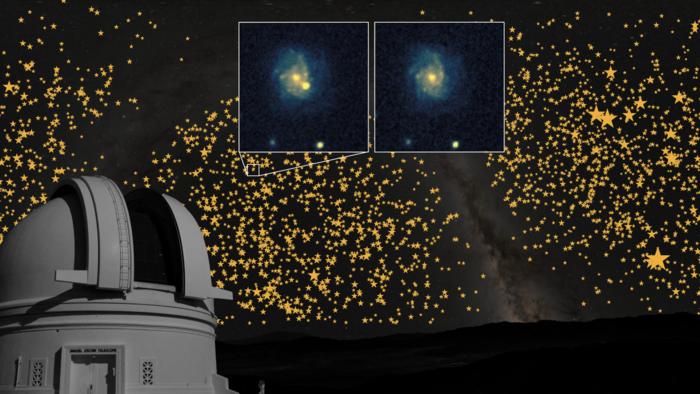
White Dwarf Star Explosions May Offer Clues on Dark Energy
www.discovermagazine.com
The Palomar 48-inch telescope at the Palomar Observatory in California with an image of the Milky Way in the background. The stars represent the number of supernovae discovered in each direction, and the inset is an image of a galaxy after (left) and before (right) the supernova exploded. (Credit:Mickael Rigault)NewsletterSign up for our email newsletter for the latest science newsThe finale of a stars life has enthralled scientists for years, yet questions continue to surround the explosions of white dwarf stars the most common path that stars take during the later stages of their evolution. New research, however, has shed light on the astounding variety of ways that a white dwarf star can explode, capturing almost 4,000 of these events scattered across the distant universe.The explosions were detailed in a dataset and a collection of 21 associated studies published in a special issue of Astronomy & Astrophysics. The large sample size was obtained by Zwicky Transient Facility (ZTF), a Caltech-led astronomical sky survey at the Palomar Observatory in San Diego County. The sheer amount of white dwarf explosions resulting from incidents like star collisions or star cannibalism may help to enlighten astrophysicists on dark energy and its potential role in the universes expansion.A White Dwarf's End At the end of most stars lives, they enter the white dwarf stage as they run out of nuclear fuel. The stars outer layers are shed, and all thats left is a core of hot matter that cools down over billions of years and eventually crystallizes.However, a white dwarfs story changes when it is part of a binary star system. In this arrangement, a white dwarf star usually pulls mass from a nearby companion star. When a white dwarf exceeds a threshold called the Chandrasekhar limit about 1.4 times the mass of the Sun it becomes primed to explode.This type of explosion, known as a type Ia supernova, has historically been used by astrophysicists to measure distances in the universe, leading them to postulate that the universe is constantly accelerating. A murky piece of this process is dark energy, an intangible force that has been proposed based on the luminosity of type Ia supernovae. Type Ia supernovae are also referred to as standard candles due to their known luminosity, which acts as the basis for determining how far the supernovae are from Earth.An Assortment of Explosions The true nature of dark energy is still being debated, but the newly observed diversity of white dwarf explosions may lead to a better understanding of the concept. The nearly 4,000 supernovae events detected by ZTF represent the largest sample size to date, introducing an expanded perspective on the end of many white dwarf stars' lives.Thanks to ZTFs unique ability to scan the sky rapidly and deeply, it has been possible to discover new explosions of stars up to one million times fainter than the dimmest stars visible to the naked eye, said Kate Maguire, an astrophysics professor at Trinity College Dublin involved with the research, in a statement.ZTFs observations showed a range of different explosion events, including collisions of two stars and even instances of cannibalism, in which a white dwarf star consumes its companions in binary systems.The array of explosions also varied in terms of luminosity, which will aid researchers in their search for answers to dark energy and the acceleration of the universe.The diversity of ways that white dwarf stars can blow up is much greater than previously expected, resulting in explosions that range from being so faint they are barely visible to others that are bright enough to see for many months to years afterwards, said Maguire, in a statement.Article SourcesOur writers at Discovermagazine.com use peer-reviewed studies and high-quality sources for our articles, and our editors review for scientific accuracy and editorial standards. Review the sources used below for this article:European Space Agency. Gaia reveals how Sun-like stars turn solid after their demiseCenter for Astrophysics. Neutron Stars and White DwarfsJack Knudson is an assistant editor at Discover with a strong interest in environmental science and history. Before joining Discover in 2023, he studied journalism at the Scripps College of Communication at Ohio University and previously interned at Recycling Today magazine.1 free article leftWant More? Get unlimited access for as low as $1.99/monthSubscribeAlready a subscriber?Register or Log In1 free articleSubscribeWant more?Keep reading for as low as $1.99!SubscribeAlready a subscriber?Register or Log In
0 Reacties
·0 aandelen
·67 Views


